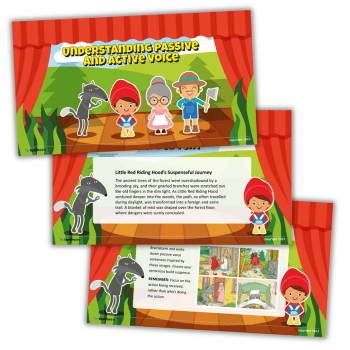Editable model text and PowerPoint/PDF lesson
KS2
Years 3-6
Dive deeper into the world of grammar with this passive voice KS2 lesson and accompanying model text. Equip your students with a robust understanding, enabling them to write clearly and confidently…
Passive voice KS2 lesson
Use this detailed PowerPoint lesson, centred around the familiar tale of Little Red Riding Hood, to help pupils understand the passive voice and how to use it to build suspense.
This resource uses the I/WE/YOU teaching model for a structured approach. We’ve also provided a model text to solidify understanding. This features both passive and active voice instances for practical analysis.
We’ve interwoven theory with handpicked examples from the ‘Little Red Riding Hood’ tale. This ensures students grasp the concept and practically differentiate between passive and active structures. It’s like giving them magic glasses to see grammar in action.
The PowerPoint also features captivating images from Little Red Riding Hood to inspire students to craft their own suspenseful passive voice sentences.
We’ve also included an annotated model text, offering a narrative that blends passive and active sentences to build suspense in a story.
Perfect for classroom discussions, it’s a hands-on way for students to dissect and appreciate the beauty of well-constructed sentences.
By the end of this journey, your students will be crafting their suspenseful take on Little Red Riding Hood. They’ll be artfully using the passive voice to amplify the story’s drama and suspense.
What is passive voice?
The passive voice is a grammatical construction where the subject of a sentence receives the action of the verb, rather than performing the action.
In the nuts and bolts of sentence construction, there’s an active agent (the ‘doer’) and often a recipient of that action. Typically, in the active voice, the subject or the ‘doer’ of the action takes the lead.
For example, in, “The wolf chased Little Red Riding Hood”, the wolf is at the forefront, actively chasing.
But what if our emphasis shifts from the chaser to the chased? That is where the passive voice comes into play. In this scenario, the action’s recipient becomes the main focus. For example, “Little Red Riding Hood was chased by the wolf.”
Notice the difference? In the passive form, the importance leans more on Little Red and the act of being chased.
Getting your head around this can be tricky, so giving students ample time and examples is essential. It’s also helpful to explain the different reasons why the passive voice might be used in writing.
With a bit of practice, students will be able to use the passive voice effectively in their own writing.
Emma Cate Stokes is a freelance writer and former primary teacher. Follow Emma at @emmccatt. Browse more active and passive voice KS2 resources.

Similar resources
- No Refuge – Graphic novel activities about refugees for UKS2
- Short story writing – Author-led resources for KS1 and KS2
- Christmas activity sheets – KS1 / KS2 fun & educational printables
- Learning gaps – How to ensure no pupil drifts too far
- Writing horror – Write a scary scene with Fear Files: Hide & Seek










